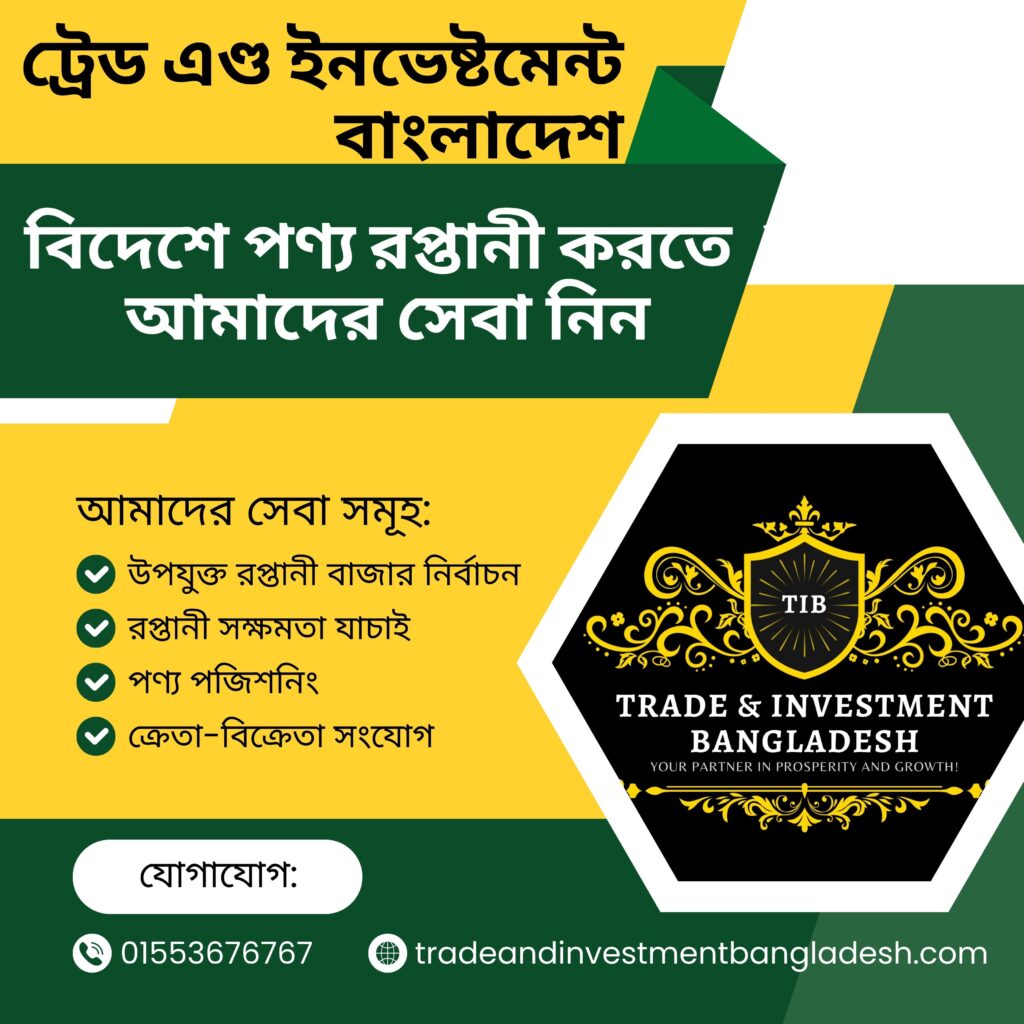
The Art of Successful Commercial Due Diligence
The Art of Successful Commercial Due Diligence
Md. Joynal Abdin*
Business Consultant & Digital Marketer
Co-Founder & CEO of Trade & Investment Bangladesh
In the dynamic landscape of business, success hinges not only on visionary strategies but also on a profound understanding of the intricacies that underlie potential ventures. Enter the realm of “The Art of Successful Commercial Due Diligence,” a comprehensive exploration into the strategic practice that serves as the bedrock for informed decision-making in the corporate arena.
Commercial Due Diligence is an indispensable process that transcends mere financial scrutiny; it is a nuanced art form that entails meticulous investigation and analysis. This endeavor extends beyond the balance sheets, delving into the core elements that drive business viability and success. As markets evolve and competition intensifies, the ability to navigate through the complexities of potential commercial ventures becomes a defining factor for sustainable growth.
This exploration seeks to unravel the layers of Commercial Due Diligence, offering a roadmap to not just decipher financial indicators but to discern the subtle nuances that shape industry landscapes. From market dynamics and competitive positioning to regulatory landscapes and growth potential, this journey invites business leaders, investors, and decision-makers to cultivate a discerning eye—an eye trained to identify opportunities and mitigate risks effectively.
Through insightful case studies, expert interviews, and practical insights, “The Art of Successful Commercial Due Diligence” aims to empower professionals with the knowledge and acumen required to make strategic decisions that stand the test of time. Join us in this exploration as we unveil the keys to unlocking the full potential of commercial opportunities and mastering the delicate dance of due diligence in the ever-evolving world of business.
Definition & Purpose of Commercial Due Diligence:
Commercial Due Diligence (CDD) stands as a pivotal process within the realm of business strategy and decision-making. It represents a thorough investigation and analysis undertaken by businesses, investors, or acquirers to evaluate the commercial viability and potential risks associated with a particular investment, acquisition, or business opportunity. Going beyond the financial metrics, CDD delves deep into various facets of a target company, seeking to uncover critical insights that enable informed decision-making and strategic planning.
Definition: At its core, Commercial Due Diligence can be defined as a meticulous investigation and assessment of the commercial aspects of a business or investment opportunity. This process involves scrutinizing not only the financial health of the target but also its market positioning, growth prospects, competitive landscape, operational efficiency, regulatory compliance, and other factors that can significantly impact the success of the investment.
While financial due diligence primarily focuses on the historical and current financial performance of a target, Commercial Due Diligence takes a broader view. It seeks to answer critical questions such as:
- Market Dynamics: What is the size and growth potential of the target market? How does the target company fit into the larger industry landscape?
- Competitive Positioning: Who are the key competitors, and what is the target’s market share? How does the target differentiate itself in the market?
- Operational Efficiency: How well is the target company managed? Are there opportunities for operational improvements or synergies?
- Customer and Supplier Relationships: What is the nature of relationships with customers and suppliers? Are there any dependencies or risks associated with these relationships?
- Regulatory and Legal Compliance: Is the target in compliance with relevant regulations and laws? Are there any legal risks that could impact the investment?
- Technology and Innovation: What is the technological landscape of the target industry? How innovative is the target company in adapting to technological advancements?
- Management and Team: Who are the key members of the management team, and what is their track record? How capable and experienced is the team in steering the company towards success?

Purpose: Commercial Due Diligence serves multiple strategic purposes, providing a holistic view of a potential investment or business opportunity. The overarching goals include:
- Risk Mitigation: One of the primary purposes of Commercial Due Diligence is to identify and assess risks associated with a potential investment. By scrutinizing various aspects of the target, from market risks to operational challenges, CDD enables stakeholders to make informed decisions and implement risk mitigation strategies.
- Informed Decision-Making: CDD equips decision-makers with a comprehensive understanding of the target’s commercial landscape. This knowledge is instrumental in making informed decisions about whether to proceed with an investment, acquisition, or business partnership.
- Value Enhancement: Beyond risk mitigation, CDD helps identify opportunities for value enhancement. This could involve recognizing synergies, operational improvements, or untapped market potential that can contribute to the overall value proposition of the investment.
- Strategic Planning: Armed with insights from Commercial Due Diligence, stakeholders can develop strategic plans that align with the target’s strengths and weaknesses. This may involve devising growth strategies, operational improvements, or market expansion initiatives.
- Negotiation and Deal Structuring: CDD findings play a crucial role in negotiation processes and deal structuring. Whether it’s negotiating the purchase price, defining performance metrics, or outlining post-acquisition integration plans, the insights derived from CDD guide these critical aspects of the deal-making process.
- Investor Confidence: For investors, whether institutional or individual, a robust Commercial Due Diligence process instills confidence in their investment decisions. It provides a transparent and thorough assessment of the target, reducing uncertainties and enhancing investor trust.
- Regulatory Compliance: Ensuring compliance with applicable regulations and laws is a critical aspect of Commercial Due Diligence. This not only mitigates legal risks but also ensures that the investment aligns with ethical and legal standards.
- Long-Term Viability: By examining the target company’s market positioning, competitive strengths, and growth potential, CDD contributes to assessing its long-term viability. This is particularly important for investors seeking sustainable and enduring returns on their investments.
In the fast-paced and complex landscape of business, Commercial Due Diligence emerges as a strategic compass, guiding stakeholders through the intricacies of investment decisions. It goes beyond the quantitative aspects, offering a qualitative understanding of the target’s commercial landscape. From risk mitigation to value enhancement, CDD serves as a linchpin for effective decision-making, ensuring that investments align with strategic objectives and contribute to long-term success. As businesses continue to navigate an ever-evolving landscape, the art of successful Commercial Due Diligence remains an indispensable tool for those seeking to make prudent and impactful business decisions.
Commercial Due Diligence Process:
The Commercial Due Diligence (CDD) process is a systematic and comprehensive investigation that aims to provide a holistic understanding of a potential investment, acquisition, or business opportunity. While the specific steps may vary based on the nature of the industry or target, a typical CDD process involves the following key stages:
- Preliminary Assessment:
The process begins with a preliminary assessment to define the scope and objectives of the Commercial Due Diligence. This stage involves understanding the key drivers of the investment, identifying critical areas for investigation, and establishing a framework for the entire process.
- Information Gathering:
The next step is to collect and compile relevant information about the target company. This includes financial documents, market studies, customer and supplier contracts, legal records, and any other data essential for a comprehensive analysis. Information gathering may involve interacting with the target’s management team, conducting interviews, and utilizing external sources.
- Market Analysis:
A crucial aspect of Commercial Due Diligence is evaluating the target’s position within its market. This involves assessing market size, growth trends, competitive landscape, and the target’s market share. Understanding the broader market dynamics is essential for contextualizing the target company’s performance and potential.
- Financial Due Diligence:
While Financial Due Diligence is a distinct process, it is integral to Commercial Due Diligence. This stage involves a detailed examination of the target’s financial statements, historical performance, cash flow analysis, and identification of any irregularities or red flags. Financial metrics provide a quantitative foundation for the broader commercial analysis.
- Operational Assessment:
An in-depth examination of the target company’s operations is critical for identifying operational efficiencies, potential synergies, and areas for improvement. This includes assessing production processes, supply chain management, technology infrastructure, and overall operational effectiveness.
- Regulatory and Legal Compliance:
Ensuring that the target company complies with relevant regulations and laws is paramount. This stage involves a thorough review of legal documents, contracts, licenses, and any potential legal liabilities. Non-compliance can pose significant risks and impact the overall success of the investment.
- Management and Team Evaluation:
The effectiveness and experience of the management team play a pivotal role in the success of any business. This stage involves evaluating the key members of the management team, assessing their track record, and understanding their strategic vision for the company. A capable and experienced leadership team is a positive indicator for the potential success of the investment.
- Customer and Supplier Relationships:
Examining the relationships the target maintains with customers and suppliers is crucial. Understanding the nature of these relationships, potential dependencies, and any risks associated with them is essential for gauging the stability and resilience of the business model.
- Synergy Identification:
For acquisitions or strategic partnerships, identifying potential synergies is a key aspect of the CDD process. This involves assessing how the target’s strengths and capabilities align with the acquiring or partnering entity, with the goal of maximizing value through collaboration.
- Reporting and Recommendations:
The findings from each stage of the Commercial Due Diligence process are compiled into a comprehensive report. This report outlines the key insights, risks, opportunities, and recommendations for stakeholders. The report serves as a strategic guide for decision-makers, providing a basis for negotiation, deal structuring, and post-acquisition integration planning.
The Commercial Due Diligence process serves as a powerful tool for strategic decision-making, offering a comprehensive analysis of a potential investment or business opportunity. By navigating through market dynamics, financial intricacies, operational nuances, and legal landscapes, stakeholders can make informed decisions that align with their strategic objectives. As businesses continue to navigate a dynamic and competitive environment, the art of successful Commercial Due Diligence remains a linchpin for those seeking to unlock the full potential of their investments.

Structures and Features of a Good Commercial Due Diligence Report:
A well-structured and comprehensive Commercial Due Diligence (CDD) report is essential for providing stakeholders with the insights necessary for informed decision-making. The report should not only present findings but also offer a strategic perspective on the potential investment or business opportunity. Here are key structures and features that contribute to a good CDD report:
- Executive Summary:
Concise overview: Summarize the key findings, risks, and opportunities.
Strategic insights: Provide a high-level strategic assessment.
- Introduction:
Define the scope and objectives of the CDD.
Outline the key questions and concerns addressed in the report.
- Market Analysis:
Market size and growth: Evaluate the target’s market and its growth potential.
Competitive landscape: Analyze competitors, market share, and positioning.
Industry trends: Highlight relevant trends impacting the market.
- Financial Overview:
Financial statements: Present a detailed analysis of balance sheets, income statements, and cash flow statements.
Financial performance: Assess historical performance and identify trends.
Financial modeling: Include any financial models used in the analysis.
- Operational Assessment:
Efficiency and scalability: Evaluate the operational efficiency of the target.
Supply chain analysis: Assess supply chain strengths, weaknesses, and dependencies.
Technology infrastructure: Examine the technology systems supporting operations.
- Regulatory and Legal Compliance:
Regulatory landscape: Summarize relevant industry regulations.
Compliance assessment: Detail the target’s compliance with applicable laws.
Legal risks: Identify potential legal risks and liabilities.
- Management and Team Evaluation:
Key personnel: Evaluate the experience and capabilities of the management team.
Leadership effectiveness: Assess the leadership team’s track record and strategic vision.
Succession planning: Discuss plans for key personnel transitions.
- Customer and Supplier Relationships:
Customer base: Analyze the nature and stability of customer relationships.
Supplier relationships: Assess dependencies and risks associated with suppliers.
Contractual obligations: Highlight key contractual commitments.
- Synergy Identification:
Identify potential synergies with the acquiring or partnering entity.
Assess how the target’s strengths align with the strategic goals of stakeholders.
- Risk Assessment:
Systematic risk analysis: Categorize and assess identified risks.
Quantify potential impacts: Provide insights into the potential financial and operational impacts of risks.
Mitigation strategies: Propose strategies to mitigate identified risks.
- Recommendations:
Strategic guidance: Offer recommendations based on the analysis.
Decision support: Provide insights to aid stakeholders in making informed decisions.
Next steps: Outline suggested actions for moving forward.
- Appendices:
Supporting documentation: Include relevant documents, charts, and graphs.
Methodology: Detail the methodologies and tools used in the analysis.
- Conclusion:
Summarize key takeaways and the overall strategic assessment.
Reiterate the implications of the findings for stakeholders.
Key Features of a Good CDD Report:
- Clarity and Conciseness: Ensure the report is clear, concise, and easily digestible. Use a logical structure with well-defined sections.
- Strategic Focus: Align findings with strategic implications. Provide insights that aid in decision-making.
- Data Accuracy and Reliability: Ensure data presented is accurate, up-to-date, and reliable. Clearly cite sources and methodologies used.
- Comprehensive Coverage: Cover all relevant aspects, including market, financial, operational, legal, and strategic considerations. Address potential risks and opportunities comprehensively.
- Professional Presentation: Use professional formatting and language. Include charts, graphs, and visuals to enhance understanding.
- Actionable Recommendations: Provide clear and actionable recommendations. Align recommendations with the strategic goals of stakeholders.
- Future Outlook: Include insights into the future outlook of the target. Consider how external factors may impact the business.
A well-crafted Commercial Due Diligence report serves as a strategic document that guides stakeholders in making sound business decisions. Its value lies not only in the thoroughness of the analysis but also in the ability to communicate complex information in a way that facilitates understanding and action.

Why do you need commercial due diligence?
Commercial Due Diligence (CDD) is a crucial step in the decision-making process for businesses, investors, and acquirers. It serves several essential purposes that contribute to informed, strategic, and successful decision-making. Here are some key reasons why commercial due diligence is necessary:
- Risk Mitigation:
Identifying Risks: CDD helps identify and assess potential risks associated with the investment, acquisition, or business opportunity. This includes financial risks, market risks, operational risks, and legal risks.
Quantifying Impacts: By understanding the nature and magnitude of risks, stakeholders can quantify potential impacts and develop strategies to mitigate or manage them effectively.
- Informed Decision-Making:
Holistic Understanding: CDD provides a comprehensive understanding of the commercial aspects of the target, going beyond financial metrics. This includes market dynamics, competitive positioning, operational efficiency, regulatory compliance, and more.
Objective Evaluation: Decision-makers can make informed and objective decisions based on a thorough analysis of the target’s commercial landscape.
- Strategic Planning:
Aligning with Objectives: CDD ensures that the investment aligns with the broader strategic objectives of the acquiring or investing entity. It helps assess how the target fits into the overall business strategy and goals.
Long-Term Viability: Evaluating the target’s market positioning and growth potential contributes to strategic planning for long-term success.
- Value Enhancement:
Identifying Synergies: CDD helps identify potential synergies between the target and the acquiring entity, maximizing the overall value proposition.
Operational Improvements: By highlighting areas for operational enhancements, CDD contributes to value creation and increased profitability.
- Negotiation and Deal Structuring:
Negotiating from Strength: The insights from CDD provide a solid foundation for negotiation processes, enabling stakeholders to negotiate favorable terms and conditions.
Optimizing Deal Structure: CDD assists in structuring deals that align with strategic goals and minimize risks, contributing to successful negotiations.
- Investor Confidence:
Transparent Assessment: CDD builds investor confidence by providing a transparent and thorough assessment of the target. Investors are more likely to be confident in their decisions when backed by comprehensive due diligence.
Reducing Uncertainties: Investors appreciate a reduction in uncertainties, which is achieved through a rigorous and transparent due diligence process.
- Regulatory Compliance:
Mitigating Legal Risks: Ensures compliance with relevant regulations and laws, reducing the likelihood of legal challenges and associated costs.
Ethical Standards: CDD ensures that the investment aligns with ethical and legal standards, mitigating reputational risks associated with legal non-compliance.
- Operational Excellence:
Efficiency Gains: By identifying operational inefficiencies, CDD contributes to enhanced operational excellence, leading to improved business performance.
Technology Alignment: CDD assesses the technology infrastructure and recommends alignment with industry best practices, fostering operational efficiency.
- Post-Acquisition Integration:
Smoothing Integration: CDD insights facilitate smoother post-acquisition integration by identifying potential challenges and offering solutions.
Cultural Fit: Assessing cultural compatibility between the acquiring and target entities contributes to a more seamless integration process.
- Timely Decision-Making:
Accelerated Decision Cycles: CDD streamlines decision-making processes by providing timely and relevant information, reducing the time required for investment decisions.
Faster Time to Market: Enables quicker entry into markets or industries by expediting the due diligence process.
- Competitive Advantage:
Strategic Differentiation: Positions the organization as a strategic player in the market, capable of making well-informed and strategic investment decisions.
Proactive Risk Management: Demonstrates a proactive approach to risk management, giving the organization a competitive edge in the business landscape.
In summary, Commercial Due Diligence is a necessary and valuable process that provides a robust foundation for decision-makers, helping them navigate risks, capitalize on opportunities, and ensure that their investments align with strategic objectives for long-term success.
Closing Remarks:
In the intricate tapestry of business, “The Art of Successful Commercial Due Diligence” unfolds as a guide to mastering the delicate dance of strategic decision-making. As we conclude this exploration into the realms of market dynamics, financial scrutiny, operational efficiency, and risk mitigation, it becomes evident that Commercial Due Diligence transcends the mere evaluation of numbers; it encapsulates the essence of foresight and strategy.
Navigating the complexities of the business landscape demands a keen understanding of not just the quantitative metrics but the qualitative nuances that shape success. This journey through the art of Commercial Due Diligence underscores the significance of informed decision-making, risk mitigation, and the pursuit of opportunities that may lie beneath the surface.
As stakeholders, investors, and decision-makers, we find ourselves armed with a strategic compass, honed through the insights of this exploration. The comprehensive analysis of market dynamics equips us to discern trends, anticipate shifts, and position ourselves strategically. Financial due diligence becomes a tool for not only understanding historical performance but for forecasting the financial trajectory that lies ahead.
The operational lens of due diligence unravels the intricacies of efficiency, scalability, and technology alignment, guiding us toward operational excellence. Legal and regulatory landscapes are demystified, ensuring that our endeavors are not only profitable but also ethically grounded.
In the realm of people and leadership, we recognize that success hinges not only on financial acumen but on the strength and vision of the management team. The alignment of cultures and the identification of synergies emerge as pillars supporting the integration of businesses, leading to value creation and sustained success.
“The Art of Successful Commercial Due Diligence” is more than a guide; it is a testament to the commitment to excellence in decision-making. It is a reminder that, in the dynamic currents of the business world, success is not accidental but a result of intentional, informed, and strategic choices.
As we embrace the lessons learned and insights gained, let us embark on our future endeavors with the confidence that comes from mastering this art. May our due diligence be not only diligent but truly strategic, paving the way for sustained growth, resilience, and success in the ever-evolving landscape of business.
The Art of Successful Commercial Due Diligence

Mr. Md. Joynal Abdin is a Business Consultant & Digital Marketer based in Dhaka, Bangladesh. He is Founder & CEO, Trade & Investment Bangladesh and Co-Founder & CEO of Bangladesh Trade Center. Previously he served at Dhaka Chamber of Commerce & Industry (DCCI) as Executive Secretary; DCCI Business Institute (DBI) as Executive Director; SME Foundation as Deputy Manager; and the Federation of Bangladesh Chambers of Commerce & Industry (FBCCI) as Assistant Secretary.
The list of services Mr. Abdin is offering includes but not limited to Business Mentorship, Business Research and Documentations, Export Market Selection and Product Positioning at Home and Abroad; Buyers-Sellers Matchmaking; Website Development; Search Engine Optimization (SEO); and Social Media Marketing etc.